

FISH pour le diagnostic préimplantatoire génétique. This article describes the selection of suitable probes for single-cell FISH, spreading techniques for blastomere nuclei, and in situ hybridization and signal scoring, applied to pre-implantation genetic diagnosis (PGD) in a clinical setting.
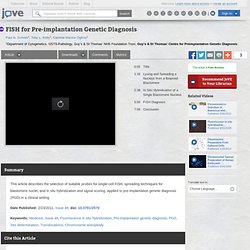
Date Published: 2/23/2011, Issue 48; doi: 10.3791/2570 Keywords: Medicine, Issue 48, Fluorescence in situ hybridization, Pre-implantation genetic diagnosis, PGD, Sex determination, Translocations, Chromosome aneuploidy Scriven, P. N., Kirby, T. L., Ogilvie, C. Pre-implantation genetic diagnosis (PGD) is an established alternative to pre-natal diagnosis, and involves selecting pre-implantation embryos from a cohort generated by assisted reproduction technology (ART). 1. Cell lysis buffer for spreading cells (0.2% Tween20 in 0.01 M HCl, pH 2.0) should be prepared 24 hours in advance and stored at -20°C Prepare 100 mL and filter 20 mL into a 30 mL sterile universal container using a sterile 20 mL syringe and syringe filter. Virtual Frog Dissection. The Medical Biochemistry Page.
The Biology Project: Cell Biology. En español Cell Membranes Learn that membranes are fluid, with components that move, change, and perform vital physiological roles as they allow cells to communicate with each other and their environment.
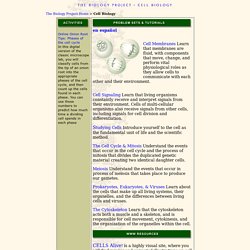
Cell Signaling Learn that living organisms constantly receive and interpret signals from their environment. Cells of multi-cellular organisms also receive signals from other cells, including signals for cell division and differentiation. Studying Cells Introduce yourself to the cell as the fundamental unit of life and the scientific method. The Cell Cycle & Mitosis Understand the events that occur in the cell cycle and the process of mitosis that divides the duplicated genetic material creating two identical daughter cells. PCR Virtual Lab. Primers are short pieces of DNA that are made in a laboratory.

Since they're custom built, primers can have any sequence of nucleotides you'd like. In a PCR experiment, two primers are designed to match to the segment of DNA you want to copy. New Self-Cloning Lizard Found in Vietnam Restaurant. {*style:<b>You could call it the surprise du jour: A popular food on Vietnamese menus has turned out to be a lizard previously unknown to science, scientists say. </b>*} What's more, the newfound is no run-of-the-mill reptile —the all-female species reproduces via cloning, without the need for male lizards.
Single-gender lizards aren't that much of an oddity: About one percent of lizards can reproduce by parthenogenesis, meaning the females spontaneously ovulate and clone themselves to produce offspring with the same genetic blueprint. (Related: "Virgin Birth Expected at Christmas—By Komodo Dragon. " ) "The Vietnamese have been eating these for time on end," said herpetologist L. Universcience VOD - La plate-forme vidéo des sciences et des technologies. Curiosphere.tv - Vidéos et ressources éducatives pour primaire, collège et lycée. How Water Shapes DNA. Water molecules surround the genetic material DNA in a very specific way.
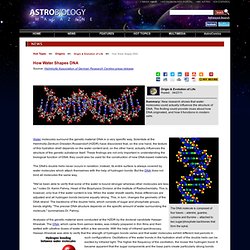
Scientists at the Helmholtz-Zentrum Dresden-Rossendorf (HZDR) have discovered that, on the one hand, the texture of this hydration shell depends on the water content and, on the other hand, actually influences the structure of the genetic substance itself. These findings are not only important in understanding the biological function of DNA; they could also be used for the construction of new DNA-based materials. The DNA's double helix never occurs in isolation; instead, its entire surface is always covered by water molecules which attach themselves with the help of hydrogen bonds. Digital microscope. KEGG Encyclopedia. Virtual Cell Animation Collection.
Animations interactives pour l'apprentissage des sciences. Animations. All Non-Africans Part Neanderthal, Genetics Confirm. If your heritage is non-African, you are part Neanderthal, according to a new study in the July issue of Molecular Biology and Evolution.

Discovery News has been reporting on human/Neanderthal interbreeding for some time now, so this latest research confirms earlier findings. Damian Labuda of the University of Montreal's Department of Pediatrics and the CHU Sainte-Justine Research Center conducted the study with his colleagues. They determined some of the human X chromosome originates from Neanderthals, but only in people of non-African heritage. "This confirms recent findings suggesting that the two populations interbred," Labuda was quoted as saying in a press release. His team believes most, if not all, of the interbreeding took place in the Middle East, while modern humans were migrating out of Africa and spreading to other regions. The ancestors of Neanderthals left Africa about 400,000 to 800,000 years ago. Fast forward to 2010, when the Neanderthal genome was sequenced. Scientists observe single gene activity in living cells in detail for first time.
Researchers at Albert Einstein College of Medicine of Yeshiva University have for the first time observed the activity of a single gene in living cells.
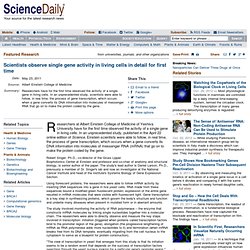
In an unprecedented study, published in the April 22 online edition of Science, Einstein scientists were able to follow, in real time, the process of gene transcription, which occurs when a gene converts its DNA information into molecules of messenger RNA (mRNA) that go on to make the protein coded by the gene. Robert Singer, Ph.D., co-director of the Gruss Lipper Biophotonics Center at Einstein and professor and co-chair of anatomy and structural biology, is senior author of the paper. The study's lead author is Daniel Larson, Ph.D., previously a member of Dr. Singer's lab and now an investigator at the National Cancer Institute and head of the institute's Systems Biology of Gene Expression Section. Using florescent proteins, the researchers were able to follow mRNA activity by inserting DNA sequences into a gene in live yeast cells.
Agitation de neurones. Biologie en flash. MyExperiment. Biology Animation Library. DAVID: Gene Functional Classification. What does this tool do?
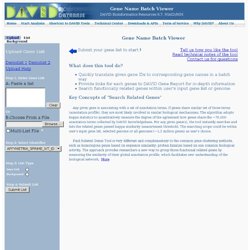
Quickly translate given gene IDs to corresponding gene names in a batch way Provide links for each genes to DAVID Gene Report for in-depth information Search functionally related genes within user's input gene list or genome Key Concepts of "Search Related Genes" Any given gene is associating with a set of annotation terms. If genes share similar set of those terms (annotation profile), they are most likely involved in similar biological mechanisms. The algorithm adopts kappa statistics to quantitatively measure the degree of the agreement how genes share the ~75,000 annotation terms collected by DAVID knowledgebase. For any given gene(s), the tool instantly searches and lists the related genes passed kappa similarity measurement threshold.
Find Related Genes Tool is very different and complementary to the common gene clustering methods, such as homologous genes based on sequence similarity; protein families based on one common biological activity. Protocoles de laboratoires - Biologie moléculaire. VCAC: Cellular Processes: Electron Transport Chain: The Movie. Learn.Genetics™ SANTE ANIMALE ET PROTECTION ANIMALE. Methods and protocols in molecular biology. - GFP Applications Page designed by Wallace Marshall, Yale University. PLoS Biology : Publishing science, accelerating research.
A Peer-Reviewed, Open Access Journal Current Issue.
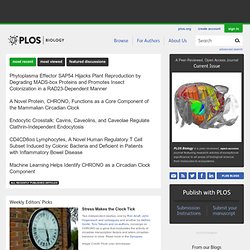
Health News - Medicine News, Health, Health Technology, Medicine Technology. TP. Génétique.